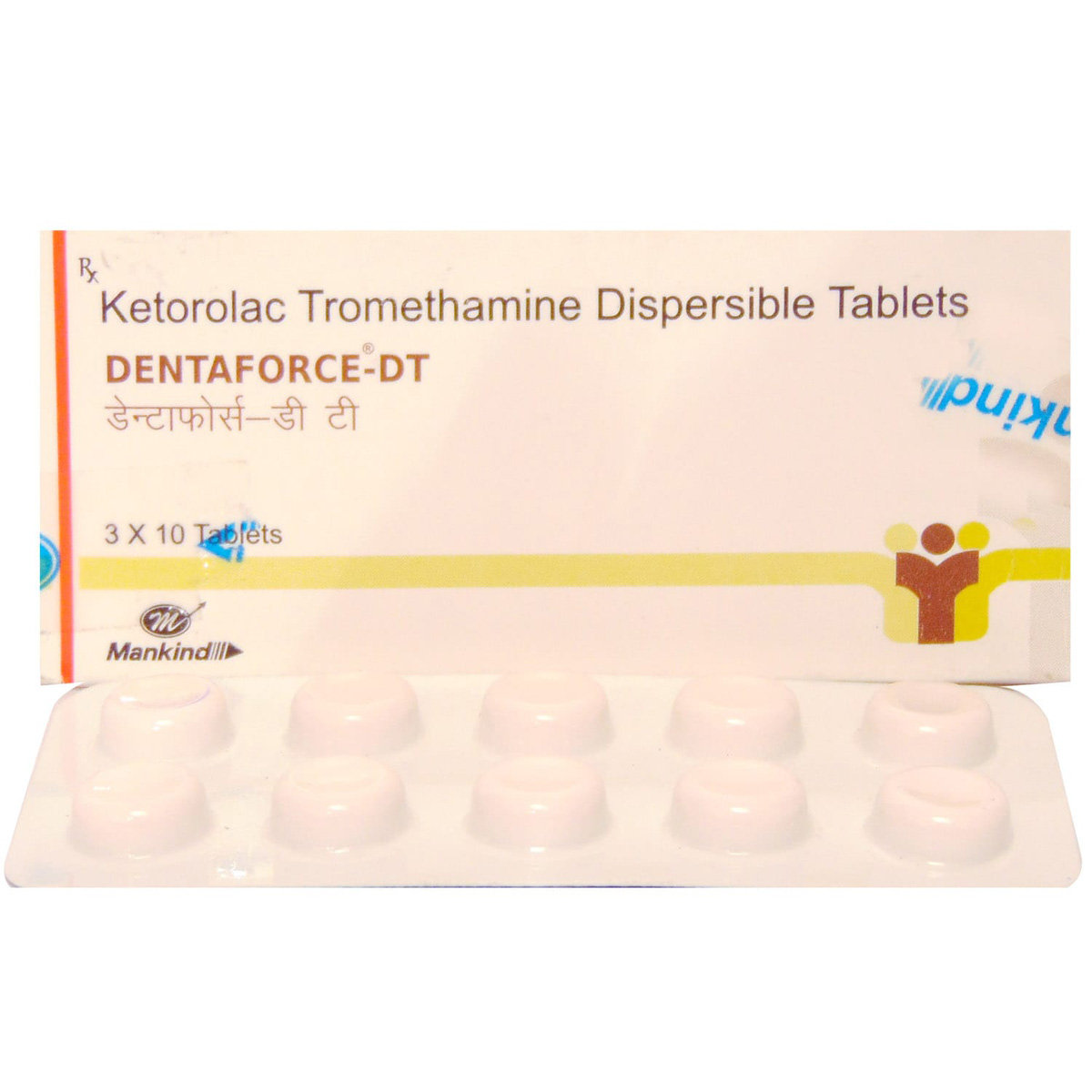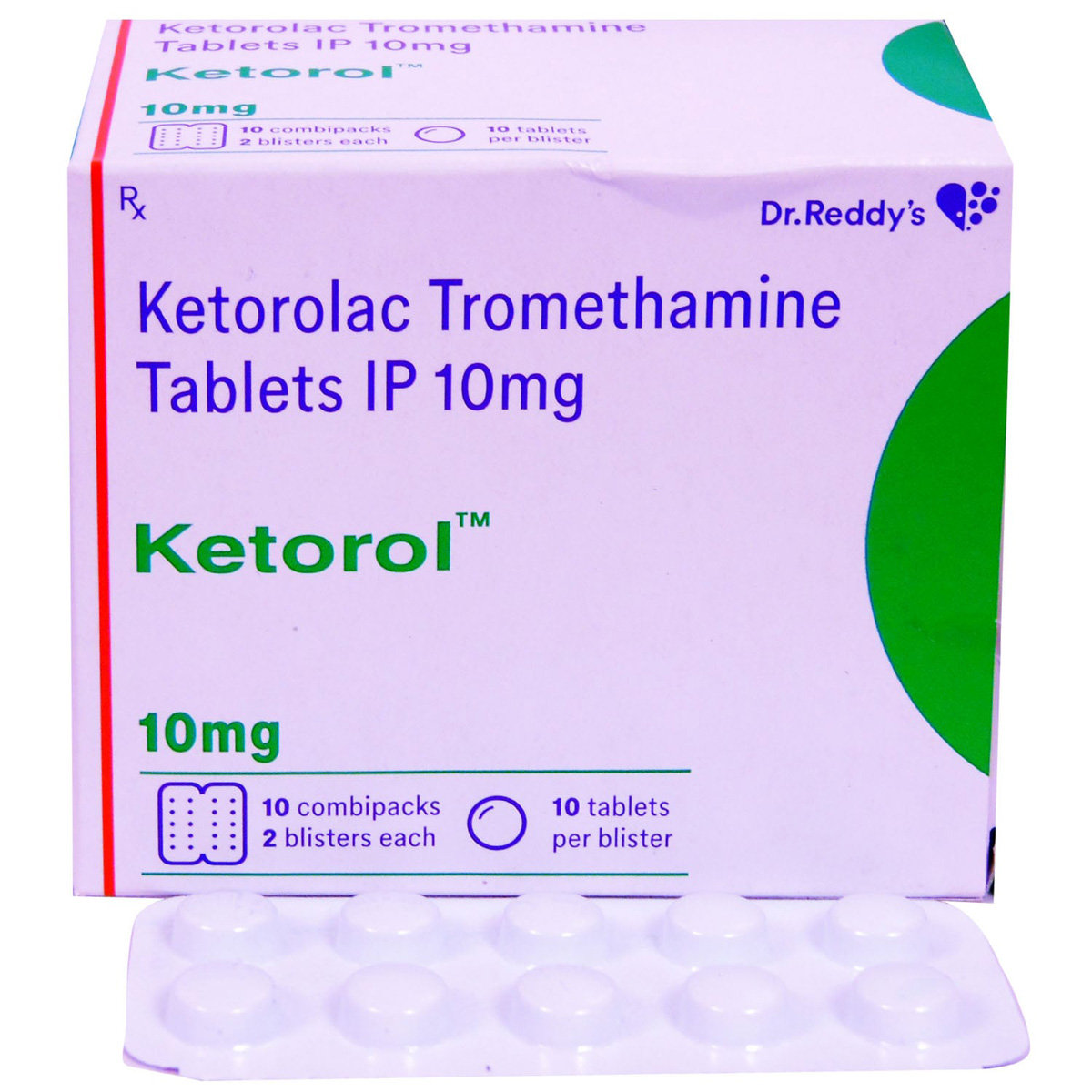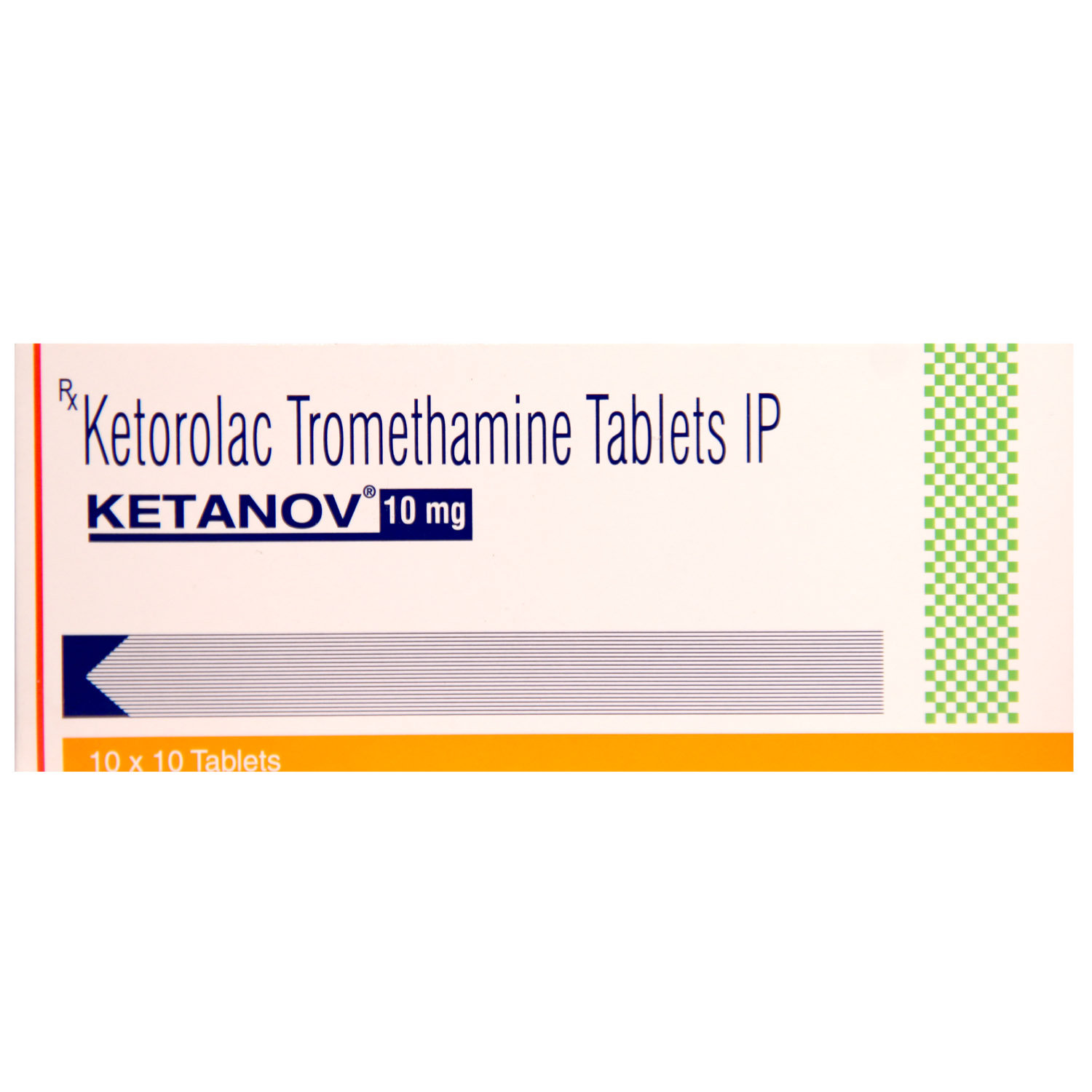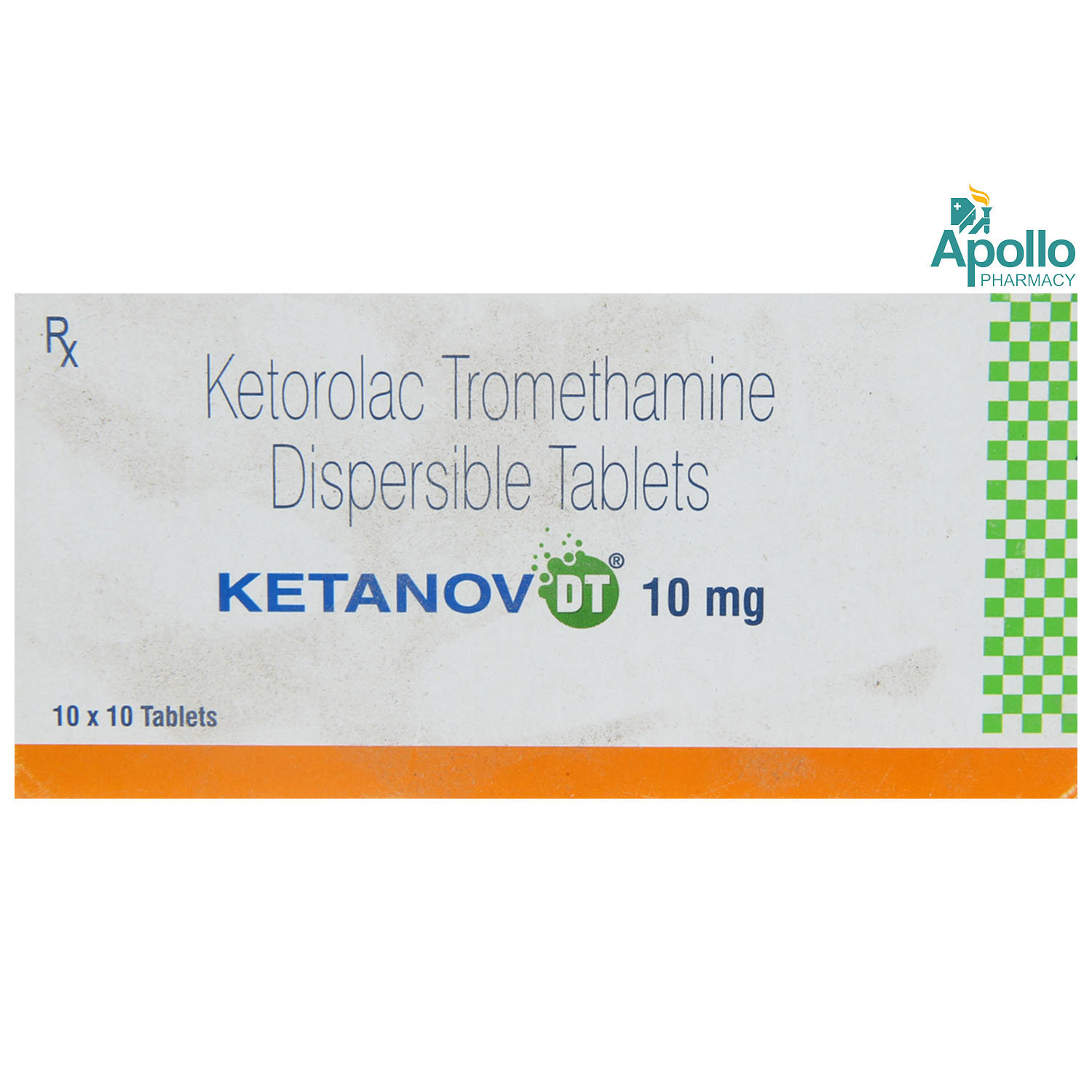Ktlac-10 DT Tablet 15's


MRP ₹109.5
(Inclusive of all Taxes)
₹16.4 Cashback (15%)
Provide Delivery Location
Online payment accepted
 Prescription drug
Prescription drugWhats That
Composition :
Manufacturer/Marketer :
Consume Type :
Expires on or after :
Return Policy :
About Ktlac-10 DT Tablet
Ktlac-10 DT Tablet belongs to a group of medicines called Non-Steroidal Anti-Inflammatory Drugs (NSAID) indicated for the short-term management of moderate to severe acute postoperative pain. Pain is a symptom triggered by the nervous system, which causes uncomfortable sensations in the body.
Ktlac-10 DT Tablet contains 'ketorolac tromethamine', which works by inhibiting the synthesis of certain chemical messengers in the body, such as prostaglandins which are responsible for causing pain and inflammation. Thereby, Ktlac-10 DT Tablet helps provide relief from pain.
In some cases, you may experience common side effects such as nausea, vomiting, stomach upset, diarrhoea, constipation, gas, and dizziness. Most of these side effects do not require medical attention and will resolve gradually over time. However, you are advised to talk to your doctor if the side effects persist or worsen.
Avoid taking Ktlac-10 DT Tablet if you are pregnant or breastfeeding. Ktlac-10 DT Tablet should not be given to children below 16 years as safety and efficacy have not been established. Avoid consuming alcohol with Ktlac-10 DT Tablet as it could lead to increased dizziness; it might also increase the risk of stomach bleeding. Keep your doctor informed about your health condition and medicines to rule out any side effects/interactions.
Uses of Ktlac-10 DT Tablet
Directions for Use
Key Benefits
Ktlac-10 DT Tablet belongs to a group of medicines called Non-Steroidal Anti-Inflammatory Drugs (NSAID) indicated for the short-term management of moderate to severe acute postoperative pain. Ktlac-10 DT Tablet contains 'ketorolac tromethamine', which works by inhibiting the synthesis of certain chemical messengers in the body, such as prostaglandins which are responsible for causing pain and inflammation. Thereby, Ktlac-10 DT Tablet helps provide relief from pain.
Storage
- Drink water or other clear fluids.
- To prevent worsening of pain, limit intake of tea, coffee, or alcohol.
- Include bland foods like rice, toast, crackers, and rice in your diet.
- Avoid lying down immediately after eating as it may cause indigestion or heartburn.
- Avoid acidic and spicy food as it may cause indigestion.
- Take medications with food (if recommended): It can help prevent stomach distress and indigestion.
- Eat smaller, more frequent meals: Divide daily food intake into smaller, more frequent meals to ease digestion.
- Avoid trigger foods: Identify and avoid foods that trigger indigestion, such as spicy, fatty, or acidic foods.
- Stay upright after eating: Sit or stand upright for at least 1-2 hours after eating to prevent stomach acid from flowing into the oesophagus.
- Avoid carbonated drinks: Avoid drinking carbonated beverages, such as soda or beer, which can worsen indigestion.
- Manage stress: To alleviate indigestion, engage in stress-reducing activities like deep breathing exercises or meditation.
- Consult a doctor if needed: If indigestion worsens or persists, consult a healthcare professional to adjust the medication regimen or explore alternative treatments.
- Inform your doctor about your constipation symptoms. They may adjust your medication or advise alternative treatments.
- Stay hydrated by drinking sufficient of water (at least 8-10 glasses a day) to help soften stool and promote bowel movements.
- Increase fibre intake by eating foods high in fibre, such as fruits, whole grains, vegetables and legumes, to help bulk up the stool.
- Establish a bowel routine by trying to go to the bathroom at the same time each day to train your bowels.
- Engaging in regular exercise, like walking or yoga, can support in bowel movement stimulation.
- Consult your doctor if constipation persists, and discuss alternative treatments or adjustments to your medication.
- Include iron-rich foods like dark leafy vegetables, lean red meat, legumes and fish in your diet.
- Consume vitamin C-rich foods as they aid iron absorption.
- Limit tea, cocoa, and coffee as these can slow iron absorption.
- Exercise regularly; however, do not overdo it.
- Reduce salt intake to minimize fluid buildup.
- Use compression stockings, sleeves, or gloves.
- Gently massage the affected area towards the heart.
- Protect the swollen area from injury and keep it clean.
- Use lotion or cream to keep the skin moisturized.
- Skin rash caused by allergies is due to irritants or allergens. Therefore, avoid contact with such irritants.
- Consult your doctor for proper medication and apply an anti-itch medication. Follow the schedule and use the medication whenever needed.
- Protect your skin from extreme heat and try to apply wet compresses.
- Soak in the cool bath, which gives a soothing impact to the affected area.
- Limit processed foods and eat more vegetables and fruits.
- Exercise at least 30 minutes every day.
- Maintain a healthy weight.
- Quit smoking as it can worsen kidney damage.
- Control your blood pressure and blood glucose.
- Limit salt intake and alcohol consumption.
Drug Warnings
Do not take Ktlac-10 DT Tablet if you are allergic to any of its contents; if you have/had asthma, severe heart problems, stomach ulcer or perforation, bleeding problems such as bleeding from the stomach, intestine or brain, bypass surgery, heart attack, blood circulation problems, or inflammation of intestines. Ktlac-10 DT Tablet can increase your risk of a fatal heart attack or stroke. So, if you have had any recent heart surgery, do not take Ktlac-10 DT Tablet . Inform your doctor if you have or had high blood pressure, heart problems, high cholesterol, diabetes, asthma, liver and kidney problems. Avoid taking Ktlac-10 DT Tablet if you are pregnant or breastfeeding. Ktlac-10 DT Tablet may cause dizziness, so drive only if you are alert. Ktlac-10 DT Tablet is not recommended for children below 16 years as safety and effectiveness have not been established. Stop taking Ktlac-10 DT Tablet and consult your doctor immediately if you have stomach pain or any signs of bleeding in the intestine or stomach, such as blood in stools. Do not take any other NSAIDs for pain relief along with Ktlac-10 DT Tablet unless prescribed.
Drug-Drug Interactions
Drug-Drug Interactions
Login/Sign Up
Combining Ktlac-10 DT Tablet with Aspirin can increase the risk of adverse effects.
How to manage the interaction:
Taking Aspirin with Ktlac-10 DT Tablet is not recommended, as it results in an interaction, it can be taken if advised by a doctor. Do not stop using any medications without a doctor’s advice.
Taking Ketorolac with Flurbiprofen can increase the risk of side effects in the gastrointestinal tract such as inflammation, bleeding, ulceration.
How to manage the interaction:
Taking Flurbiprofen with Ktlac-10 DT Tablet is not recommended, but it can be taken if your doctor has advised it. However, if you experience dizziness, lightheadedness red or black, tarry stools, coughing up or vomiting fresh or dried blood that looks like coffee grounds, severe headache and weakness contact your doctor immediately. Do not discontinue any medications without first consulting your doctor.
Taking Ketorolac with Celecoxib can increase the risk of gastrointestinal bleeding and ulcers,
How to manage the interaction:
Taking Ktlac-10 DT Tablet with Celecoxib is not recommended, but can be taken together if prescribed by a doctor. However, consult a doctor if you experience dizziness, lightheadedness, red or black, tarry stools, coughing up or vomiting fresh or dried blood that looks like coffee grounds, severe headache and weakness. Do not stop using any medications without first talking to your doctor.
Using Ktlac-10 DT Tablet together with piroxicam may increase the risk of side effects.
How to manage the interaction:
Taking Piroxicam with Ktlac-10 DT Tablet is not recommended as it can cause an interaction, it can be taken if prescribed by the doctor. Consult a doctor if you experience any unusual bleeding or bruising, dizziness, lightheadedness, red or black, tarry stools, coughing up or vomiting fresh or dried blood that looks like coffee grounds, severe headache, and weakness. Do not stop using any medications without talking to a doctor.
The combined use of Ktlac-10 DT Tablet and Tenofovir alafenamide can increase the risk of kidney problems.
How to manage the interaction:
Taking Ktlac-10 DT Tablet and Tenofovir alafenamide together can lead to an interaction, it can be taken if advised by your doctor. However, if you experience any symptoms like nausea, vomiting, loss of appetite, increased or decreased urination, sudden weight gain or weight loss, fluid retention, swelling, shortness of breath, bone pain, muscle cramps, tiredness, weakness, dizziness, confusion, and irregular heart rhythm, contact your doctor immediately. Do not discontinue any medications without consulting your doctor.
Co-administration Ktlac-10 DT Tablet and Apixaban may raise the risk of bleeding.
How to manage the interaction:
Even though combining Ktlac-10 DT Tablet and Apixaban may cause an interaction, it is still possible to take it if your doctor advises you to. Consult a doctor if you experience symptoms like blood in your urine or stool (or a black stool), severe bruising, prolonged nosebleeds, feeling dizzy or lightheaded, weakness or severe headache, vomiting blood or coughing up blood, heavy menstrual bleeding (in women), difficulty breathing, or chest pain. Without consulting a doctor, never stop taking any medications.
Drug-Food Interactions
Drug-Food Interactions
Login/Sign Up
Diet & Lifestyle Advise
- Exercising regularly helps in muscle stretching so that they are less likely to spasm, tear and sprain. Mild exercises such as jogging and walking are helpful for muscle stretching.
- Massages can also be helpful.
- Avoid freezing and hot temperatures.
- Avoid wearing tight-fitting clothes; instead, wear loose garments.
- Rest well, and get plenty of sleep.
- To avoid developing pressure sores, change your position every two hours.
- Hot or cold therapy can help treat muscle spasms. Apply an ice-pack or hot-pack on the muscle for 15-20minutes.
- Stay hydrated, drink plenty of water.
Side Effects of Ktlac-10 DT Tablet
- Nausea
- Vomiting
- Diarrhoea
- Constipation
- Gas
- Stomach upset
- Dizziness
Habit Forming
Therapeutic Class
All Substitutes & Brand Comparisons
RX
Dentaforce-DT Tablet 10's
Mankind Pharma Pvt Ltd
₹57
(₹5.13 per unit)
21% CHEAPERRX
Out of StockKartil-DT Tablet 15's
Ind-Swift Ltd
₹90
(₹5.4 per unit)
17% CHEAPERRX
Out of StockKetogem 10 Tablet 10's
Agron Remedies Pvt Ltd
₹60
(₹5.4 per unit)
17% CHEAPER
Product Substitutes
Author Details
We provide you with authentic, trustworthy and relevant information
Drug-Diseases Interactions
Drug-Diseases Interactions
Login/Sign Up
FAQs
Ktlac-10 DT Tablet works by inhibiting the synthesis of certain chemical messengers which are responsible for causing pain and inflammation. Thereby, Ktlac-10 DT Tablet helps provide relief from pain.
Diarrhoea might be a side-effect of Ktlac-10 DT Tablet . Drink enough fluids and eat non-spicy food if you experience diarrhoea. Consult your doctor if you experience severe diarrhoea or if you find blood in stools.
Do not take any other pain killer medicines along with Ktlac-10 DT Tablet unless prescribed, as it might lead to unpleasant side effects and can increase the risk of stomach bleeding associated with NSAIDs.
Ktlac-10 DT Tablet is usually prescribed for less than 5 days. It should not be taken for longer durations. The lowest possible dose for the shortest duration is advised. Take Ktlac-10 DT Tablet only for as long as your doctor has prescribed. Avoid taking Ktlac-10 DT Tablet for longer durations as it might increase the risk of heart problems and stomach bleeding.
Ktlac-10 DT Tablet might affect fertility. Therefore, Ktlac-10 DT Tablet is not recommended for women trying to conceive. Please consult your doctor if you have any concerns.
Drug-Drug Interactions Checker List
- WARFARIN
- HEPARIN
- LITHIUM
- ASPIRIN
- PROBENECID
- MIFEPRESTONE
Disease/Condition Glossary
Pain: Pain is a symptom triggered by the nervous system, causing uncomfortable sensations in the body. Pain may be dull or sharp; it might be constant or may come and go. Pain can be generalized (overall body aches) or localized (affecting a specific body area). The common causes of pain include headache, muscle strain, cramps, cuts, bone fractures, arthritis, and stomach ache.

Have a query?
Buy best C.n.s Drugs products by
Intas Pharmaceuticals Ltd
Sun Pharmaceutical Industries Ltd
Torrent Pharmaceuticals Ltd
Alkem Laboratories Ltd
Abbott India Ltd
Cipla Ltd
Alteus Biogenics Pvt Ltd
Micro Labs Ltd
Lupin Ltd
Ipca Laboratories Ltd
D D Pharmaceuticals Pvt Ltd
Icon Life Sciences
Mankind Pharma Pvt Ltd
Tripada Healthcare Pvt Ltd
Arinna Lifesciences Ltd
Linux Laboratories Pvt Ltd
East West Pharma India Pvt Ltd
La Renon Healthcare Pvt Ltd
Talent India Pvt Ltd
Tas Med India Pvt Ltd
Zydus Healthcare Ltd
Cnx Health Care Pvt Ltd
Eris Life Sciences Ltd
Leeford Healthcare Ltd
Emcure Pharmaceuticals Ltd
Macleods Pharmaceuticals Ltd
Sigmund Promedica
Aristo Pharmaceuticals Pvt Ltd
Dr Reddy's Laboratories Ltd
Troikaa Pharmaceuticals Ltd
Consern Pharma Ltd
Zydus Cadila
Shine Pharmaceuticals Ltd
Wockhardt Ltd
Ardent Life Sciences Pvt Ltd
Crescent Formulations Pvt Ltd
Theo Pharma Pvt Ltd
Reliance Formulation Pvt Ltd
Ikon Pharmaceuticals Pvt Ltd
Propel Healthcare
Neon Laboratories Ltd
Jagsam Pharma
Msn Laboratories Pvt Ltd
Morepen Laboratories Ltd
Pulse Pharmaceuticals
Sanofi India Ltd
Med Manor Organics Pvt Ltd
Hetero Healthcare Pvt Ltd
Novartis India Ltd
Crescent Therapeutics Ltd
Elder Pharmaceuticals Ltd
Solvate Laboratories Pvt Ltd
Akumentis Healthcare Ltd
Mova Pharmaceutical Pvt Ltd
Psyco Remedies Ltd
Tripada Lifecare Pvt Ltd
Ajanta Pharma Ltd
Cyrus Remedies Pvt Ltd
Medishri Healthcare Pvt Ltd
Cadila Healthcare Ltd
Glenmark Pharmaceuticals Ltd
Matteo Health Care Pvt Ltd
Hbc Life Sciences Pvt Ltd
Lyf Healthcare
Matias Healthcare Pvt Ltd
Mesmer Pharmaceuticals
Alembic Pharmaceuticals Ltd
Capital Pharma
Crescent Pharmaceuticals
Medopharm Pvt Ltd
Alniche Life Sciences Pvt Ltd
Kivi Labs Ltd
Talin Remedies Pvt Ltd
USV Pvt Ltd
Quince Lifesciences Pvt Ltd
Solis Pharmaceuticals
Infivis Life Care
Zuventus Healthcare Ltd
Cadila Pharmaceuticals Ltd
Pfizer Ltd
Wallace Pharmaceuticals Pvt Ltd
A N Pharmacia Laboratories Pvt Ltd
Blue Cross Laboratories Pvt Ltd
Jenburkt Pharmaceuticals Ltd
Lia Life Sciences Pvt Ltd
Mano Pharma
Medley Pharmaceuticals Ltd
Primus Remedies Pvt Ltd
FDC Ltd
Maneesh Pharmaceuticals Ltd
Apex Laboratories Pvt Ltd
Gagnant Healthcare Pvt Ltd
Ozone Pharmaceuticals Ltd
RPG Life Sciences Ltd
Strides Shasun Ltd
Unichem International
GlaxoSmithKline Pharmaceuticals Ltd
Kuresys Labs Pvt Ltd
LA Pharma
Trion Pharma India Llp
Alcohol
Safe if prescribed
Avoid consumption of alcohol while taking Ktlac-10 DT Tablet as it may cause increased dizziness. It may also increase the risk of stomach bleeding.
Pregnancy
Consult your doctor
Avoid taking Ktlac-10 DT Tablet if you are pregnant or planning for pregnancy. Please consult your doctor if you have any concerns.
Breast Feeding
Consult your doctor
Ktlac-10 DT Tablet is not recommended during breastfeeding as Ktlac-10 DT Tablet might pass into breastmilk.
Driving
Safe if prescribed
Ktlac-10 DT Tablet may cause dizziness and drowsiness. Do not drive or operate machinery unless you are alert.
Liver
Consult your doctor
Dose adjustment may be needed in patients with liver impairment. Please consult your doctor if you have a liver impairment or any concerns regarding this.
Kidney
Consult your doctor
Dose adjustment may be needed in patients with kidney impairment. Please consult your doctor if you have kidney impairment or any concerns regarding this. Ktlac-10 DT Tablet is not recommended for patients with advanced renal impairment and patients at risk for renal failure.
Children
Safe if prescribed
Ktlac-10 DT Tablet is recommended for children below 16years as the safety and effectiveness were not established.








_0.jpg?tr=q-85)

